After more than 4 months of development we are happy to announce the availability of Maps Marker Pro v2.8. This release marks an important milestone, as it adds support for keyless geocoding providers – allowing you and your clients to use Maps Marker Pro without any additional registration or API key.
To keep up with this new keyless approach for basemaps too, we also changed Google basemaps support for new installations. Google Maps support is now disabled by default (for new installations) as Google API keys for basemaps are mandatory since June 2016.
In order to offer more choice for our users, we also added new new keyless basemaps from Stamen maps and OpenStreetMap variant support – allowing your to customise your maps even better.
We also did a usability review (thx Wieland!) and as a result reorganized the settings area completely as well as adding many subtle changes, making it easier especially for unexperienced users to create new maps.
An update to the latest version is – as always – highly recommended. For more details about this release please see below.
Let us know what you think about this new release by submitting a review or leaving a comment below!
If you want to keep up to date with the latest Maps Marker Pro development, please follow @MapsMarker on twitter (= most current updates), on Facebook, Google+ or subscribe to news via RSS or via RSS/email.
We would also like to invite you to join our affiliate program which offers commissions up to 50%. If you are interested in becoming a reseller, please visit https://www.mapsmarker.com/reseller

We want YOU for Maps Marker Pro!
Join our team as a freelance developer and apply now!
https://www.mapsmarker.com/join-the-team
Now let´s get to the highlights of pro v2.8:
The major highlight of this release is the support for new geocoding providers. Geocoding is the process of transforming a description of a location – like an address, name or place – to a location on the earth’s surface. Maps Marker Pro allows you to choose from different geocoding providers dynamically on marker and layer edit pages:
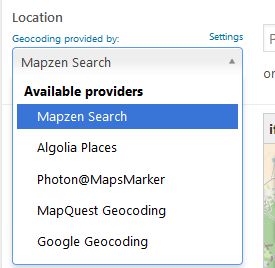
The following keyless geocoding providers can be used out of the box:
The following geocoding provider require a mandatory API key registration:
For a comparison of all currently available geocoding provider please see the following table:
| Name + setup tutorial | API key needed? | Rate limits |
|---|---|---|
| LocationIQ Geocoding (Default for new installations) | No | Keyless geocoding with 1,000 requests/day/IP, 2 requests/second; with personalized free API key up to 5.000 requests/day/IP - larger plans available on demand - details here |
| TomTom Geocoding | Yes | 2.500 requests/day, 5 requests/minute; details about larger plans at https://developer.tomtom.com/store/maps-api |
| Google Geocoding | Yes | minimum billing per month applies (starting from 11th June 2018 - click here for details) |
| MapQuest Geocoding | Yes | 15.000 transactions/month and a maximum of 10 requests/second; higher quotas are available |
| Stadia Maps Geocoding | Yes | 200.000 credits / month, details at Stadia Maps Pricing |
| Algolia Places (discontinued) | No | n/a |
In order to get more targeted search results, each provider offers different options to optimize its results (e.g. by setting a local focus point, restricting the results to a country) – please click here for a related tutorial.
If a provider is unavailable or your rate limit is reached, the fallback geocoding provider chosen in settings is automatically used:
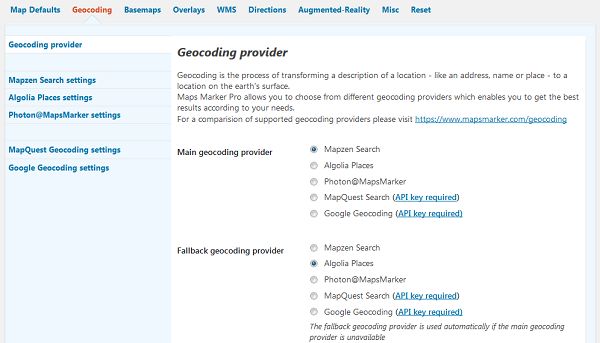
OpenStreetMap now has a dedicated basemap settings section at Settings / Basemaps / OpenStreetMap and allows you to choose the OpenStreetMap variant to use:
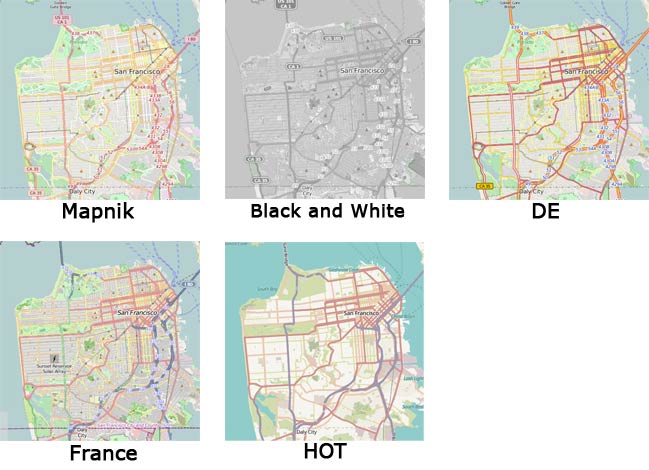
The chosen variant will be applied to all maps with OpenStreetMap as basemap.
For over a decade, Stamen has been exploring cartography with their clients and in research. Their map tiles are made available as part of the CityTracking project, funded by the Knight Foundation, in which Stamen is building web services and open source tools to display public data in easy-to-understand, highly visual ways.
With v2.8 the following Stamen basemaps can be used out-of-the-box for your maps, without any additional registration. The related settings can be found at Settings / Basemaps / Stamen Maps.
Stamen Toner variants:
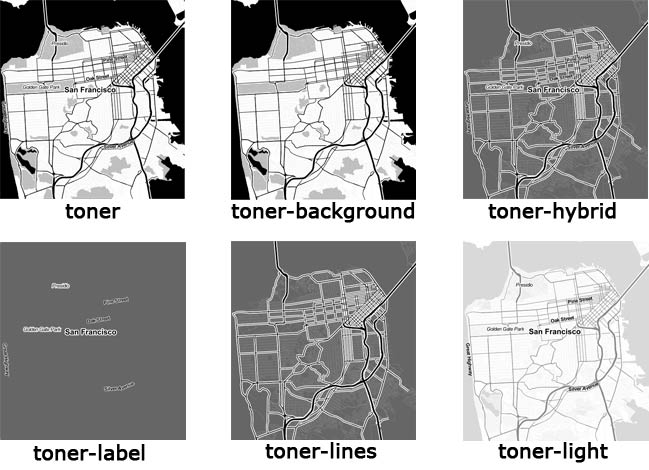
Stamen Terrain variants:
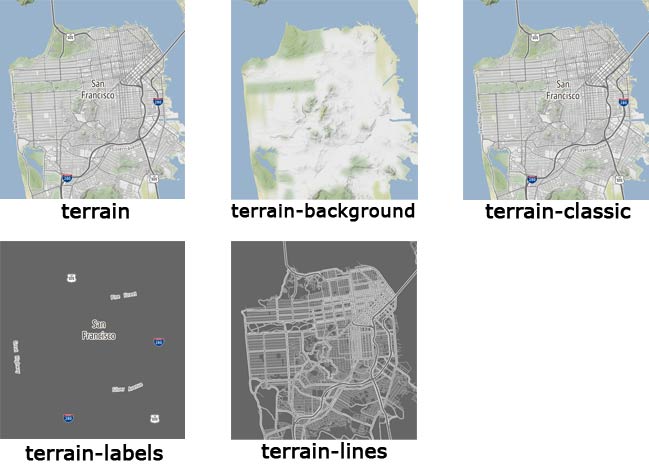
Stamen Watercolor:
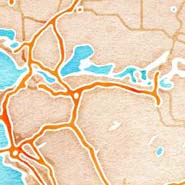
MapQuest basemaps were broken since July 11th 2016, as MapQuest requires a mandatory API key since. With this release you can now use MapQuest again as basemap – a tutorial on how to register a MapQuest API key can be found here.
If MapQuest is set as basemaps for some of your maps and no API key has been given yet, those maps will now automatically switch to OpenStreetMap as basemap until an API key is not set. In addition, an info about the affected maps will be shown on backend – allowing you to either register an API key or change the basemap of the affected maps manually.
In addition, we also added support for MapQuest Hybrid basemap, which can now be selected after a mandatory API key was set:
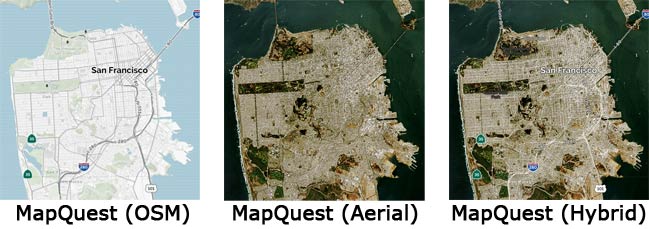
With this release we also changed the default custom basemaps 1-3 and custom overlays :
Please be aware that those new custom basemaps are available by default for new installations only, as we do not want to overwrite any custom settings here!
If you upgraded from an older version to this release and want to use those basemaps too, either reset the settings in the appropriate settings section or clear all related settings fields at Settings / Basemaps / Custom basemap 1-3 or at Settings / Overlays / Custom Overlay 1-4 which results in default settings being used after pressing the save button.
In order to support our new “keyless out-of-the-box approach”, the “Google Maps JavaScript API” has also been disabled for new installations due to mandatory API key needed for displaying Google basemaps since June 2016.
So if you want to use Google basemaps for your maps, you need to first register an API key and enable the “Google Maps Javascript API” – a tutorial can be found here.
With this release, we also looked for ways to improve the performance of our plugin. The following improvements potentials were identified and implemented with this release:
We did a comprehensive usability review together with Wieland from http://user-experience.wien/ and as a result the following usability optimizations were added – focusing on making our plugin easier to understand, especially for new users:
The “list all layers” page on backend now also supports paging and sort, which results in better performance and usability especially for users with lots of layers:

Currently more than 180 translators are helping in providing more than 46 translations, many thanks to all of you! Translations can easily be added on our glotpress site at https://translate.mapsmarker.com and translators are entitled for free Maps Marker Pro licenses and free access to updates and support in exchange for their valuable contribution.
Getting a professional license key worth €249 in exchange for help with translations now even got easier, as we lowered the level of completeness needed: now <=80% is needed instead of <=50% completeness. If you are interested in becoming a translator, please see https://translate.mapsmarker.com for more information.
Maps Marker Pro includes a javascript API which can be utilized by developers to attach events handlers to markers and layers. The following enhancements have been added with this release:
Please see the related API docs at https://www.mapsmarker.com/jseventsapi for more details.
With Chrome 50 Google made a significant change to the geolocation support of its browser: all applications requesting the current position of the user (not just for Maps Marker Pro´s geolocation feature) are only allowed anymore to retrieve the current position of the user if the site is setup to be delivered securely via https – users will see the following warning instead:
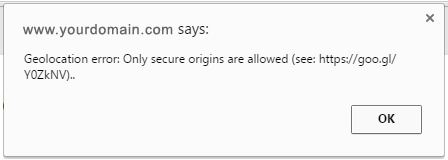
See more details about this decision by Google at https://developers.google.com/web/updates/2016/04/geolocation-on-secure-contexts-only. Geolocation will still work on non-https sites if the users access the site via alternative browsers like Firefox, Safari or Internet Explorer – anyway it could be likely that those browsers will also add a similar security restriction in the future.
So if you need the Maps Marker Pro geolocation featue on your site, it is highly recommended to migrate your site to https. Some hosters already provide free https certificates from letsencrypt.org for example. For configurations needed within your WordPress site in order to configure it to support https, please have a look at tutorials like https://css-tricks.com/moving-to-https-on-wordpress/.
As https has more advantages for your site than just geolocation working again with Google Chrome 50+ (like securing the data integrity, sender authentication and user privacy as well as higher Google ranking as https is used as ranking signal), we strongly advise to switch your site to https only if you haven´t done so yet.
Thanks to many motivated contributors, this release includes the following updated translations:
If you want to contribute to translations (new Hindi translators would be appreciated!), please visit https://translate.mapsmarker.com/projects/lmm for more information.
Please note that translators are also compensated for their contribution – for example if a translation is finished less than 50%, the translator receives a free 25 licenses pack worth €249 as a compensation for completing the translation to 100%.
Please understand that we are not able to promise any release dates for new features. The roadmap for major new features gives you an idea where Maps Marker Pro is heading – anyway we just want to keep the flexibility to add optimizations and bugfixes with rather unplanned minor releases resulting mostly from users feedback.
Please subscribe to this blog (via RSS or Email) or follow @MapsMarker on twitter (= most current updates) if you want to stay up to date with the latest development news.
| support for geocoding providers Mapzen Search, Algolia Places, MapQuest Geocoding, Photon@MapsMarker | |
| add support OpenStreetMap variants (Mapnik, Black&White, DE, France, HOT) | |
| add support for Stamen basemaps terrain & toner | |
| add support for MapQuest (Hybrid) basemap | |
| compatibility check for “Geo Redirect” plugin (thx Vladislav!) | |
| add .htaccess file to plugin folder to explicitly allow direct access to specific PHP plugin files (thx Nikos!) | |
| new Leaflet.markercluster option “animate” for smoothly splitting/merging cluster children (enabled by default) | |
| add info texts about marker/layer concept to better assist new users | |
| add loading indicators on license settings page to show progress of license validation | |
| new filter mmp_before_setview which allowing to utilize the map load-event (thx Jose!) | |
| support for OpenMapSurfer Bounds as default custom basemap 1 (enabled for new installs only) | |
| support for OpenTopoMap as default custom basemap 2 (enabled for new installs only) | |
| support for Hydda as default custom basemap 3 (enabled for new installs only) | |
| support for new default custom overlays Waymarked Trails and OpenWeatherMap (enabled for new installs only) | |
| add access to markers in MMP JS API (thx Jose!) | |
| new MMP JS API function to open a popup on a layer map (thx Rob!) | |
| add pagination for “list all layers” page on backend | |
| increase maxNativeZoom level for OpenStreetMap from 18 to 19 for higher details | |
| option “Google Maps JavaScript API” has been reset due to compatibility reasons & disabled for new installations due to mandatory API key | |
| removed compatibility fallback from https to http for tile images & API requests if locale zh (Chinese) is used | |
| reorganized settings page for better usability | |
| jump to top of list of markers below layer maps after pagination is used (thx Mark!) | |
| improved performance of marker icons loading on marker edit & tools page (by eliminating extra http requests by using base64 image encoding instead) | |
| improved performance on backend for OpenStreetMap-based maps by support for conditional & deferred Google Maps API loading | |
| trim Mapbox custom basemap parameters to prevent broken URLs | |
| updated Leaflet.markercluster codebase to v0.5.0 (thx danzel!) | |
| updated jQuery timepicker addon from v1.6.1 to v1.6.3 (bugfix release, full changelog) | |
| updated minimap addon from v3.3.0 to v3.4.0 (bugfix release) | |
| reorder menu items and collapse links to advanced features by default for better focus (thx Wieland from http://user-experience.wien/!) | |
| hide advanced layer edit functions and make them visible on click only (to better assist new users) | |
| updated default error tile image which provides possible explanations for loading issues and also suggests solutions | |
| replaced built-in-support for OGD Vienna maps with support for basemap.at (covering whole Austria, disabled by default) | |
| updated setting link to new “Google Styled Maps Wizard” | |
| disable update button on marker edit page as long as TinyMCE HTML editor is not fully loaded to prevent issues with popuptext not saving correctly (thx JunJie!) | |
| increase search process timeout from 0.5 to 1sec to better support double byte characters (thx Takeo!) | |
| add home control button on backend only when editing of existing marker or layer maps (thx Thorsten!) | |
| MapQuest basemaps were broken since July 11th 2016 (automatic fallback to OpenStreetMap for existing maps if mandatory API key is not set) | |
| unresponsive map when too much markers were loaded and marker icon or marker name in list of markers was clicked (thx Daryn!) | |
| custom post types were not found for “used in content” feature, showing where a Maps Marker Pro shortcode is used (thx Brian!) | |
| markers from layer included in mlm with filter status “no” are not loaded on frontend (thx Carles!) | |
| sort order for ID in filter controlbox was by ID text and not ID number (thx Brian!) | |
| bing attribution could disappear when map getBounds() return out range values | |
| settings page could be visible to non-admins (changes could not be made though) | |
| large icons could distort “list all markers”-page (thx Hockey!) | |
| add fix for Google.asyncWait which can cause issues on mobile devices (thx nmccready!) | |
| broken initialization of click events on filters (thx Patrick!) | |
| if option “use layer zoom level for all markers” was set, popups in clusters were not opened by using links in list of markers | |
| “Too few arguments” PHP warning for list of markers sort order (thx Martin!) | |
| PHP error log entries “Undefined variable: mapname_js” if invalid shortcode was used | |
| i18n/translation issue on marker edit page (thx Hans!) | |
| custom marker icon was not used as fallback if importer errors occured | |
| errorTile-images option for custom basemap 2&3 was not considered on marker&layer edit pages | |
| action bar for list of markers was also shown on empty layer maps even if list of markers option was unchecked | |
| unsaved-warning was shown on layer edit pages even if no changes were made | |
| vertical scrolling on marker and layer edit pages was broken on mobiles | |
| map was partially broken after exiting HTML5 fullscreen view with Google Chrome (thx Maj-Britt!) | |
| “add new layer” link was not visible below layer selection list when creating new marker | |
| OpenRouteService.org directions integration was partially broken (no start point was set due to changed layer IDs – thx Marco!) | |
| autofocus on marker/layer name on backend did not work in Google Chrome | |
| compatibility check issue with W3 Total Cache Plugin v0.9.5 only (see mapsmarker.com/w3tc-hotfix for background info) | |
| layer maps could be broken if sort by distance in list of markers is set by default (depending on PHP error log level) | |
| new layer defaults for panel, listmarkers and clustering settings were not saved if unchecked by default (thx Thorsten!) | |
| Geolocation feature does not work anymore with Google Chrome 50+ unless your site is securely accessible via https (details) | |
| Translation updates In case you want to help with translations, please visit the web-based translation plattform |
|
| changed rewards for translators: get a free professional license key worth €249 for <=80% instead of <=50% completeness | |
| updated Catalan translation thanks to Efraim Bayarri, http://replicantsfactory.com, Vicent Cubells, http://vcubells.net and Marta Espinalt, http://www.martika.es | |
| updated Chinese translation thanks to John Shen, http://www.synyan.net and ck | |
| updated Dutch translation thanks to Marijke Metz – http://www.mergenmetz.nl, Patrick Ruers, http://www.stationskwartiersittard.nl, Fokko van der Leest – http://wandelenrondroden.nl and Hans Temming – http://www.wonderline.nl | |
| updated French translation thanks to Vincèn Pujol, http://www.skivr.com and Rodolphe Quiedeville, http://rodolphe.quiedeville.org, Fx Benard, http://wp-translator.com, cazal cédric, http://www.cedric-cazal.com, Fabian Hurelle, http://hurelle.fr and Thomas Guignard, http://news.timtom.ch | |
| updated German translation | |
| updated Hungarian translation thanks to István Pintér, http://www.logicit.hu and Csaba Orban, http://www.foto-dvd.hu | |
| updated Italian translation thanks to Luca Barbetti, http://twitter.com/okibone and Angelo Giammarresi – http://www.wocmultimedia.biz | |
| updated Japanese translations thanks to Shu Higash | |
| updated Latvian translation thanks to Juris Orlovs, http://lbpa.lv and Eriks Remess http://geekli.st/Eriks | |
| updated Lithuanian translation thanks to Donatas Liaudaitis – http://www.transleta.co.uk and Ovidijus – http://www.manokarkle.lt | |
| updated Russian translation thanks to Ekaterina Golubina (supported by Teplitsa of Social Technologies – http://te-st.ru) and Vyacheslav Strenadko, http://slavblog.ru | |
| updated Spanish translation thanks to David Ramírez, http://www.hiperterminal.com, Alvaro Lara, http://www.alvarolara.com, Victor Guevara, http://1sistemas.net, Ricardo Viteri, http://www.labviteri.com, Juan Valdes and Marta Espinalt, http://www.martika.es | |
| updated Swedish translation thanks to Olof Odier http://www.historiskastadsvandringar.se, Tedy Warsitha http://codeorig.in/, Dan Paulsson http://www.paulsson.eu, Elger Lindgren, http://bilddigital.se, Anton Andreasson, http://andreasson.org/ and Tony Lygnersjö – https://www.dumsnal.se/ | |
| updated Ukrainian translation thanks to Andrexj, http://all3d.com.ua, Sergey Zhitnitsky and Mykhailo, http://imgsplanet.com | |
The easiest way to update is to use the WordPress update process: login with an user who has admin privileges, navigate to Dashboard / Updates, select plugins to update and press the button “Update Plugins”. The pro plugin checks every 12 hours if a new version is available. You can also manually trigger the update check by going to Plugins and clicking on the link “Manually check for updates” next to “Maps Marker Pro”:

If you do not see the link “Check for updates” and are using a version below 1.7, please update manually once by downloading the current package from https://www.mapsmarker.com/download-pro and overwritting the existing plugin files on your server via FTP. This might be needed on several hosts, which use outdated SSL libraries, which prevent Maps Marker Pro from making a secure connection to retrieve the update package from mapsmarker.com. Pro v1.7 includes a workaround for those kind of servers and the following updates should work again as usual. If you are affected and need help, please open a support ticket.
SHA-256 hash value:
4D5D5CD4FD7AF7F1B974B2DEF038B540C80C27F03DE6B5858A1F411884460AF8
Click here for a tutorial on how to verify the integrity of the plugin package (recommended if the plugin package for a new installation was not downloaded from https://www.mapsmarker.com – verification is not needed though if the automatic update process is used)
No additional actions on plugin update from beta to final version are required.